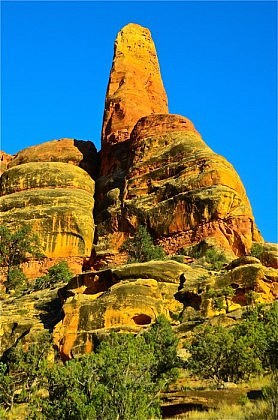As previously discussed, thunderstorms are common in the high country. They often seem to materialize out of the clear blue, and that is exactly what they do! That’s because under the right conditions, which are frequent in the summer, a clear blue sky morning can quickly become a stormy afternoon with lots of thunder and lightening. Of course, thunder is lightening. They are one and the same. Thunder is the noise made by the lightening flash, and when you see lightening, you’ll hear thunder after a brief interval, depending upon the distance. Since sound travels at about a mile every 5 seconds, if you count to ten immediately after the flash and then hear the thunder, the lightening was two miles away. If there is almost no time lapse, the high voltage is way too close! The general rule is that at five miles or less, take cover!
Of course, the first warning sign is to get a weather forecast before you leave for your guided Yellowstone backpack trek. If the Weather Service forecasts a 20% chance of afternoon thunderstorms for town (in the valley), then you can easily double that percentage to get your odds for a storm in the high country. Weather forecasts become less accurate with time, so on an extended wilderness trek, after 4 or 5 days don’t expect the forecast you heard back in town to hold up. You’re on your own! The wilderness rules! As it should. And hopefully, you’ve left your electronic communications device at home so you can experience the big wild on its own terms! Yet with a bit of practice and some simple study of a few basic meteorological principals, you can make your own back-country weather forecast. Here are just a couple of ideas to ponder.
Note the humidity. A dewy morning means there might be plenty of moisture for storm formation. If the air feels humid, then it is, and in the relatively dry Rocky Mountain climate, in the summer that usually means possible thunderstorms. Note the nighttime temperature. A cold night usually means clear dry air, but a warm night means moisture and the potential for rain or snow including thunderstorms, depending upon the situation and the season. Cumulus clouds forming shortly after breakfast? That’s a warning sign. Watch their development. If they are soon “bubbling upward”, plan for thunderstorms because those puffy cumulus will quickly grow into big dark cumulonimbus (thunderheads) clouds. In fact, buy a cloud chart and learn the basic cloud groups. Cirrus clouds with “mares tails” can mean upcoming thunderstorms or possibly a major storm front system. Morning alto-cumuli or different cloud types visible at the same time can also foretell possible storms. Forecasting weather when you’re out in the wilds does take practice, but in terrain that often produces violent thunderstorms, it’s an important skill that could possibly save your life. In the final installment of this 3-part series, we’ll look at what you should do to maximize your safety, once you are actually in a thunderstorm in mountain wilderness.



